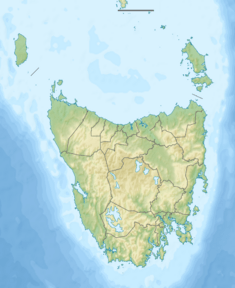Lake Margaret (Tasmania) facts for kids
Quick facts for kids Lake Margaret |
|
|---|---|
|
Location in Tasmania
|
|
| Country | Australia |
| Location | West Coast, Tasmania |
| Coordinates | 41°59′30.3″S 145°35′15″E / 41.991750°S 145.58750°E |
| Purpose | Power |
| Status | Operational |
| Opening date | 1918 |
| Owner(s) | Hydro Tasmania |
| Dam and spillways | |
| Type of dam | Gravity dam |
| Impounds | Yolande River |
| Height (foundation) | 17 m (56 ft) |
| Length | 243 m (797 ft) |
| Dam volume | 6,000 m3 (210,000 cu ft) |
| Spillways | 1 |
| Spillway type | Uncontrolled |
| Spillway capacity | 29 m3/s (1,000 cu ft/s) |
| Reservoir | |
| Creates | Lake Margaret |
| Catchment area | 21 km2 (8.1 sq mi) |
| Surface area | 170 ha (420 acres) |
| Normal elevation | 660 m (2,170 ft) AHD |
| Power station | |
| Name | Lake Margaret Power Station |
| Operator(s) | Hydro Tasmania |
| Commission date |
|
| Decommission date |
|
| Type | Conventional |
| Turbines |
|
| Installed capacity |
|
| Annual generation | 48 GWh (170 TJ) |
Lake Margaret is a concrete-faced gravity dam with an uncontrolled spillway across the Yolande River, located on the north side of Mount Sedgwick, in the West Coast Range, West Coast of Tasmania, Australia.
The impounded reservoir is also called Lake Margaret.
The dam was constructed in 1918 by the Mount Lyell Mining and Railway Company for the purpose of generating hydro-electric power via the Lake Margaret Power Station, which is located below the dam wall. Following the closure of the Mount Lyell Mining and Railway Company, in 1985 the control of the dam, lake, and power station was transferred to Hydro Tasmania.
Features and location
The dam, called Lake Margaret, was completed in 1918 and it was the first gravity dam constructed in Tasmania. It was built of concrete with conglomerate "plums". The dam wall is 17 metres (56 ft) high and is 243 metres (797 ft) long and the concrete-faced dam wall has a volume of 6,000 cubic metres (210,000 cu ft). The uncontrolled spillway has a capacity of 29 cubic metres per second (1,000 cu ft/s). In 1974 the dam wall was strengthened by the use of prestressed anchors and grouting of open joints.
The Lake Margaret dam impounds the Yolande River, which also is the outflow from the dam. Further west the Yolande joins with the Langdon River, another West Coast Range west flowing river, to join with the Henty River west of the Zeehan Highway.
Reservoir
The 170-hectare (420-acre) reservoir, also called Lake Margaret, with an elevation of 660 metres (2,170 ft) AHD , lies east of Mount Cyril, that has an elevation of 797 metres (2,615 ft), and south of Mount Geikie, that has an elevation of 1,191 metres (3,907 ft), both in the West Coast Range. Mount Sedgwick is to the south. The Bastion, at 1,107 metres (3,632 ft), which is a steep cliff face that is immediately west of Lake Magdala and north of Mount Geikie, together with Farquhar Lookout, with an elevation of 935 metres (3,068 ft), define a rough line of the northern part of the 21-square-kilometre (8.1 sq mi) catchment area.
Numerous smaller lakes – some named and some not – lie above the location of the Lake Margaret. The vesting of the catchment with the current operator of the hydro electric power station, makes the two feeder parts of the catchment specific Hydro land in contrast to the surrounding landscape which is either in the Tyndall Regional Reserve or the Lake Beatrice Conservation Area.
The two southern feeder Hydro reserves start from the slopes of Mount Sedgwick, the westerly from Lake Barnables (less than one kilometre (zero point six two miles) east of Lake Margaret), then to Lake Phillip. The eastern feeder starts at an unnamed lake to Lake Polycarp, Lake Peter, Lake Paul, Lake Apollos, and then to Lake Phillip. The northern feeder starts from Lake Monica, Lake Myra, then Lake Magdala, situated at 782 metres (2,566 ft) AHD , Lake Martha, at 757 metres (2,484 ft), and Lake Mary, at 732 metres (2,402 ft), before flowing into Lake Margaret.
The larger lower altitude natural lake of the area lies to the south east side of Mount Sedgwick and is known as Lake Beatrice.
Power scheme
The initial purpose of Lake Margaret when it was constructed by the Mount Lyell Mining and Railway Company was to generate hydroelectric power for the Queenstown-based Mount Lyell mine, railway, and surrounding community. While the mine has since closed, the purpose of Lake Margaret to generate power remains unchanged. Between 1918 and 1930 the Mount Lyell Mining and Railway Company commissioned seven conventional Pelton turbine generators with a capacity of 8.3 megawatts (11,100 hp) at the Upper Lake Margaret Power Station. Hydro Tasmania took ownership of the power station in 1985. Water travels from Lake Margaret through a woodstave 2.2-kilometre (1.4 mi) pipeline to the power station.
In 1931 a minihydro plant was constructed to provide additional power. The single Turgo turbine generates 3.2-megawatt (4,300 hp). Hydro Tasmania took ownership of the power station in 1985 and decommissioned the plant in 1994. The station was reopened in 2010 following refurbishment that included a new penstock, turbine and woodstave pipeline.


